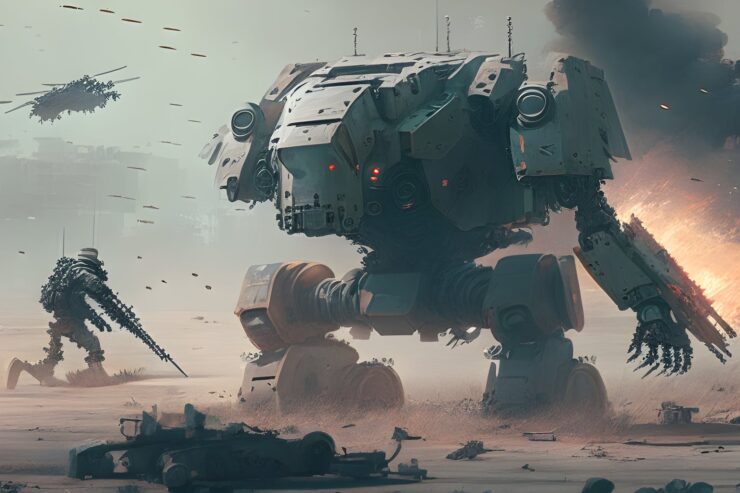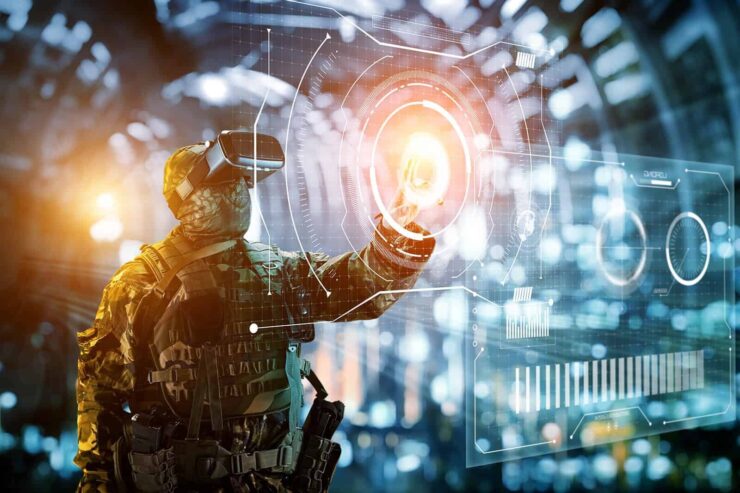
“Artificial intelligence is a double-edged sword. On the one hand, it has the potential to make wars more efficient and less destructive. On the other hand, it also raises the risk of unintended consequences, such as the proliferation of autonomous weapons that could kill without human intervention” – Max Tegmark, physicist and author of “Life 3.0: Being Human in the Age of Artificial Intelligence”.
The nature of warfare is constantly changing. Artificial intelligence (AI) is rapidly transforming the world, and the military is no exception. AI is being used to develop new weapons and systems that are more intelligent, autonomous, and lethal than ever before. This is raising a number of challenges and opportunities for warfare.
AI has multiple roles to play in military operations including:
Target identification and tracking: AI can be used to identify and track targets in real-time, even in complex environments. This can help militaries to make more informed decisions about when and where to strike.
Cyberwarfare: AI can be used to defend against cyberattacks and to launch cyberattacks of its own. This is a growing area of concern for militaries around the world.
Logistics: AI can be used to optimize logistics operations, such as the transportation of troops and supplies. This can help to improve efficiency and reduce costs.
Training: AI can be used to create personalized training programs for soldiers. This can help to improve training effectiveness and reduce the risk of injuries.
Decision-making: AI can be used to help decision-makers make better decisions in complex situations. This can be especially helpful in situations where there is a lot of uncertainty or where the stakes are high.
These are just a few of the ways that AI is being used in the military today. As AI technology continues to develop, it is likely to have an even greater impact on the way wars are fought in the years to come.
Here are some specific examples of how AI is being used in the military today:
- The US military is using AI to develop autonomous drones that can fly and attack targets without human intervention.
- The Chinese military is using AI to develop systems that can identify and track enemy ships and aircraft.
- The Israeli military is using AI to develop systems that can detect and defuse improvised explosive devices (IEDs).
- The UK military is using AI to develop systems that can analyze battlefield data and provide real-time insights to commanders.
These are just a few examples, as AI continues to develop, it is likely to have an even greater impact on the way wars are fought in the years to come.
The use of AI in the military raises a number of ethical and legal concerns. Some people worry that AI could be used to create autonomous weapons that could kill without human intervention. Others worry that AI could be used to create systems that are biased against certain groups of people. These are important concerns that need to be addressed as AI technology continues to develop.
Despite the challenges, the potential benefits of using AI in the military are significant. AI can help to make militaries more effective, efficient, and safe. It can also help to reduce the risk of human casualties. As AI technology continues to develop, it is likely to play an increasingly important role in the future of warfare.
Opportunities
AI offers a number of opportunities for warfare. AI systems can be used to improve the efficiency and effectiveness of military operations. For example, AI can be used to analyze large amounts of data to identify patterns and threats, or to develop new strategies for fighting wars. AI can also be used to create new weapons and systems that are more powerful and versatile than anything that exists today.
Another opportunity is that AI could be used to reduce the risk of war. For example, AI could be used to develop early warning systems that can detect and deter aggression. AI could also be used to negotiate peace agreements and resolve disputes peacefully.

Challenges
One of the biggest challenges of AI warfare is the potential for unintended consequences. AI systems are complex and difficult to understand, so it is possible that they could make mistakes that lead to civilian casualties or other unintended harm. Additionally, AI systems could be hacked or manipulated by adversaries, which could further increase the risk of unintended consequences.
Another challenge is the ethical implications of AI warfare. Some people argue that it is wrong to develop or use AI weapons that can make decisions about life and death without human intervention. Others argue that AI can be used to make warfare more precise and humane, by reducing the risk of civilian casualties.
Finally, AI warfare could lead to a new arms race, as countries compete to develop the most advanced AI weapons systems. This could destabilize the international security landscape and make it more difficult to prevent conflict.
The impact of AI on military domains
The impact of AI on warfare is likely to be felt across all military domains, including:
Land warfare: AI is already being used to develop autonomous ground vehicles, such as drones and robots. These vehicles could be used to conduct reconnaissance, surveillance, and even combat operations. AI could also be used to improve the performance of traditional ground forces, such as tanks and infantry.
Air warfare: AI is being used to develop autonomous aircraft, such as fighter jets and bombers. These aircraft could be used to carry out strikes with greater precision and lethality. AI could also be used to improve the performance of traditional air forces, such as air traffic control and logistics.
Sea warfare: AI is being used to develop autonomous ships and submarines. These vessels could be used to conduct surveillance, minesweeping, and even combat operations. AI could also be used to improve the performance of traditional naval forces, such as shipboard weapons systems and navigation.
Cyber warfare: AI is being used to develop new cyber weapons and defences. These weapons could be used to launch cyberattacks, steal data, or disrupt critical infrastructure. AI could also be used to improve the performance of traditional cyber forces, such as network security and incident response.
Space warfare: AI is being used to develop new space weapons and defenses. These weapons could be used to destroy satellites, interfere with communications, or launch attacks from space. AI could also be used to improve the performance of traditional space forces, such as satellite navigation and space situational awareness.
The future of AI warfare
The future of AI warfare is uncertain, but it is clear that this technology will have a significant impact on the way wars are fought. It is important to start thinking about the challenges and opportunities of AI warfare now, so that we can be prepared for the future.
Some of the key questions that need to be addressed include:
- How can we ensure that AI weapons are used responsibly and ethically?
- How can we prevent AI warfare from leading to an arms race?
- How can we use AI to reduce the risk of war?
These are just some of the challenges and opportunities that AI presents for warfare. As AI technology continues to develop, it is important to have a thoughtful and informed discussion about the future of AI warfare. Only by doing so can we ensure that this technology is used for good and not for harm.
In addition to the challenges and opportunities mentioned above, there are a number of other factors that will shape the future of AI warfare. These include:
The pace of technological innovation– AI is a rapidly developing technology, and it is difficult to predict how quickly it will advance in the future. This uncertainty makes it difficult to plan for the long-term implications of AI warfare.
The political and economic landscape– The development and use of AI warfare will be influenced by the political and economic interests of different countries. For example, countries that are more technologically advanced are likely to be more willing to invest in AI warfare.
Public’s perception of AI- The public’s perception of AI will also play a role in the development and use of AI warfare. If the public is concerned about the ethical implications of AI warfare, it may pressure governments to regulate or ban the development of certain types of AI weapons.
Conclusion
The use of AI in warfare is a complex and challenging issue. There are both risks and opportunities associated with this new technology. It is important to carefully consider the ethical implications of AI warfare and to develop international norms and regulations to govern its use. With careful planning and responsible use, AI can be a force for good in the world, helping to prevent conflict and make the world a more secure place.
-The writer is a seasoned media professional with over three decades of experience in print, electronic, and web media. He is presently Editor of Taazakhabar News. The views expressed are personal and do not necessarily reflect the views of Raksha Anirveda















